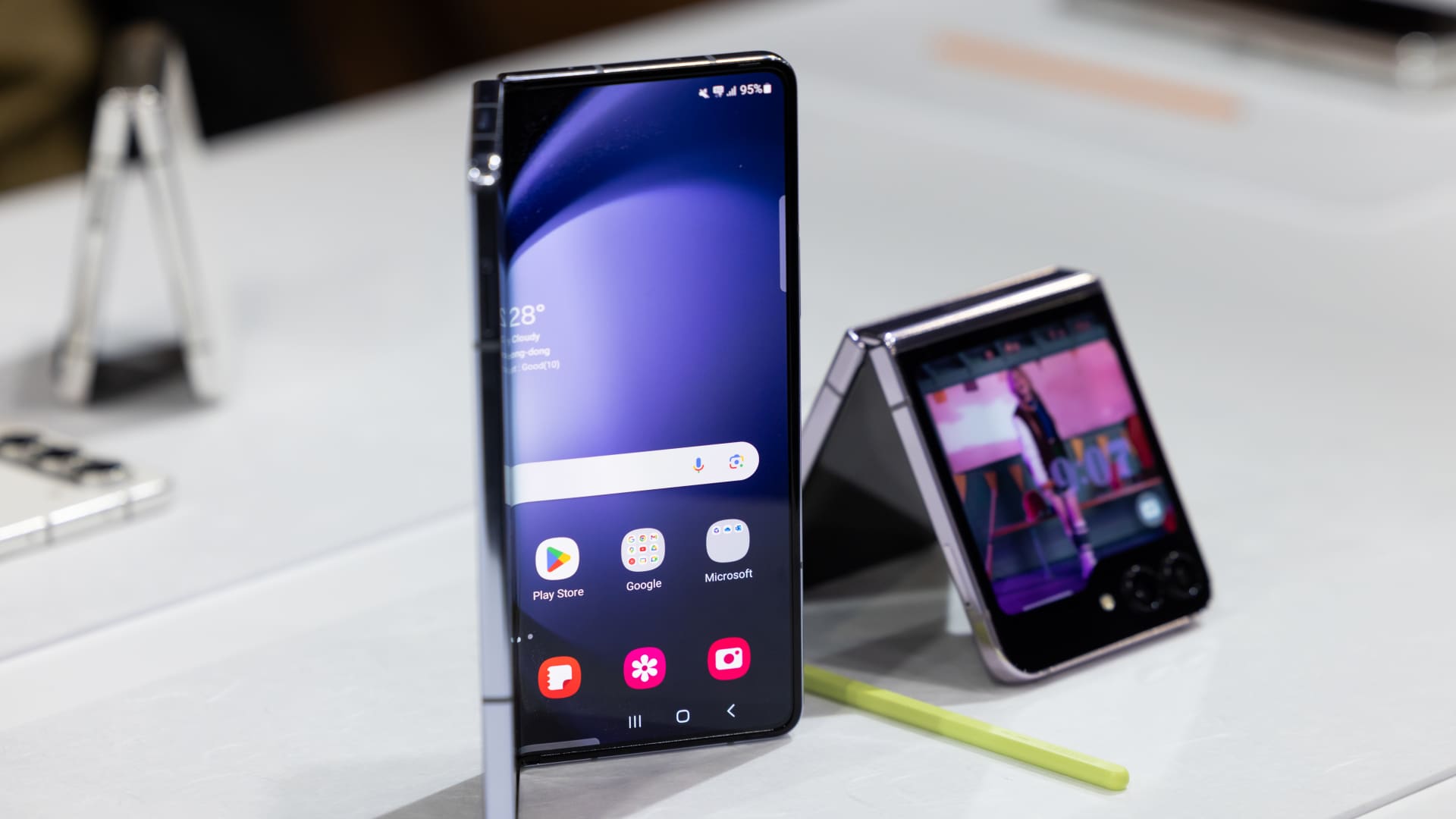Samsung reports 95% drop in profit, but expects global demand to recover in second half of the year


A Samsung Galaxy Z Fold 5 smartphone, left, a Galaxy Z Flip 5 smartphone during the Galaxy Unpacked event in Seoul, South Korea, on Wednesday, July 26, 2023. Samsung introduced the fifth generation of its foldable smartphones on Wednesday, seeking to counter a sluggish market for devices and upcoming rival products from Apple Inc.
SeongJoon Cho | Bloomberg | Getty Images
Samsung Electronics posted a second-quarter profit drop Thursday as weak demand for memory chips persists.
Here are Samsung’s second-quarter results versus estimates:
- Revenue: 60.01 trillion Korean won (about $47.21 billion), vs. 60.8 trillion Korean won expected by analysts, according to Refinitiv consensus estimates.
- Operating profit: 0.67 trillion Korean won, vs. 0.6 trillion Korean won expected by the company.
related investing news
Samsung reported sales slipped 22% from a year ago, while operating profit plunged 95%. Earlier this month, Samsung estimated second-quarter revenue to be 60 trillion Korean won and operating profit to be 600 billion Korean won.
Samsung is the world’s largest maker of dynamic random-access memory chips, which are found in consumer devices such as smartphones and computers.
“Global demand is expected to gradually recover in the second half of the year which should lead to an improvement in earnings driven by the component business,” Samsung said in its earnings report.
“However, continued macroeconomic risks could prove to be a challenge in such recovery in demand,” said the South Korean firm.
Samsung shares rose 2.29% Thursday morning.
Focus on higher-end products
Samsung said that robust artificial intelligence demand led to more DRAM shipments than expected in the second quarter, compared with the first quarter.
“The memory business saw results improve from the previous quarter as its focus on high bandwidth memory (HBM) and DDR5 products in anticipation of robust demand for AI applications led to higher-than-guided DRAM shipments,” said Samsung.
Both DRAM and NAND flash memory chips also saw “more limited price drops” which improved second-quarter performance, compared with the first quarter, Samsung said.
“As server customers continued inventory adjustment, overall purchase demand had not yet recovered. Due to the strong demand for generative AI, however, investment from the data center sector was concentrated on AI servers,” said Samsung.
High-performance memory chips are required to train generative AI models such as ChatGPT. Such chips enable generative AI models to remember details from past conversations and user preferences in order to generate humanlike responses.
“Looking to the second half of the year, the market is expected to gradually move toward stability considering increasing production cuts in the industry, while inventory adjustments by customers are likely to wind down,” said Samsung.
Samsung said it will focus on high-value-added products such as DDR5, LPDDR5x and HBM as it expects a recovery in demand, as well as increase investments in infrastructure, R&D and packaging technology.
Weak electronics demand
Samsung said that overall mobile phone market demand declined from the first quarter due to continued macroeconomic challenges such as inflation.
The hype from the Galaxy S23 series launch in the first quarter also faded, said Samsung. Delayed market recovery also posed further challenges to second-quarter sales.
“Nevertheless, the Galaxy S23 series was able to achieve higher results than its predecessor in the first half, in terms of both volume and value,” said Samsung, adding that it plans to lift sales of the Galaxy S23 and Galaxy A series.
Global shipments of smartphones are expected to decline 3.2% in 2023 to 1.17 billion units, according to global market intelligence firm International Data Corporation. The firm lowered its forecast from February, driven by factors such as “a weaker economic outlook” and “ongoing inflation.”
Smartphone and PC manufacturers are grappling with excess inventories of memory chips after stockpiling to meet increased demand for consumer devices during the pandemic. Inflation has led to consumers cutting back on purchases of these goods, driving down prices for memory chips.
“Our conversations with channels, supply chain partners, and major OEMs all point to recovery being pushed further out and a weaker second half of the year,” said Nabila Popal, IDC’s research director.
“Consumer demand is recovering much slower than expected in all regions, including China.”
In its Thursday earnings call, Samsung told analysts that it would be making additional production cuts on certain DRAM and NAND products “to further accelerate inventory normalization.”
Samsung, Micron and SK Hynix have announced capital expenditure cuts to lower production in the past months.
Focus on premium foldable phones
Samsung said it will focus on the newly launched high-end Galaxy Z Flip 5 and Galaxy Z Fold 5 series to cement its leading position in the global foldable smartphone market.
“Despite how bad the memory business is, the good thing is at least the premium part of the market is helping to drive some of their profits or at least offset some of the damage caused by the the memory side of the business,” said Bryan Ma, vice president of devices research at IDC, on CNBC’s “Squawk Box Asia” on Thursday.
But the Galaxy S23 series still drives most of Samsung’s profits in the premium smartphone space, said Ma.
“We do also have to keep in mind that foldables honestly are not a huge part of it, even if they are the premium part of the market. It’s actually more of the traditional candy bar Galaxy S23 that really drives a lot of their profits at least in the premium part,” said Ma.
Still, it gives Samsung an edge over its rival Apple. “It’s garnering mindshare. Things like a foldable phone that Apple doesn’t have yet,” said Ma.









